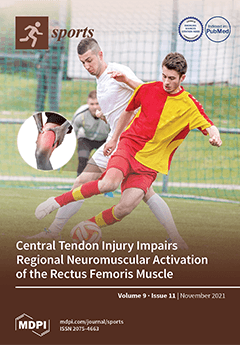Soccer teams integrate specific exercises into their typical workout programs for injury prevention. The purpose of this study was to investigate whether the incorporation of a brief and supplementary training program that involves eccentric, balance, and core exercises into the weekly soccer schedule
[...] Read more.
Soccer teams integrate specific exercises into their typical workout programs for injury prevention. The purpose of this study was to investigate whether the incorporation of a brief and supplementary training program that involves eccentric, balance, and core exercises into the weekly soccer schedule can cause positive neuromuscular adaptations. Twenty-one soccer players were randomly allocated to either a training (
n = 11) or a control group (
n = 10). All players followed their teams’ typical program, consisting of 4–5 soccer-specific sessions plus 1 match, weekly. Training group players additionally performed biweekly, hamstring eccentric, balance, and core stability exercises for 8 weeks. Isokinetic concentric and eccentric peak torque (PT) of the hamstrings and quadriceps, changes in the center of pressure (COP) during a 30 s single-leg stance, and a supine bridge (trunk stability) test were assessed before and after the intervention. After the intervention, a 27% increase in hamstring concentric PT and a 33% reduction in COP sway in the stance test, were observed for the training group only (
p < 0.05). These improvements were significant only for the non-dominant leg. Furthermore, the control group displayed an increase in COP sway during the bridge test compared to baseline values (
p < 0.05), which reflects a deterioration in postural balance over time. Consequently, incorporating small doses of hamstring eccentric, proprioception, and core stability exercises into a typical training program of youth soccer players improves strength and postural balance in the non-dominant leg, as well as core muscle performance.
Full article






